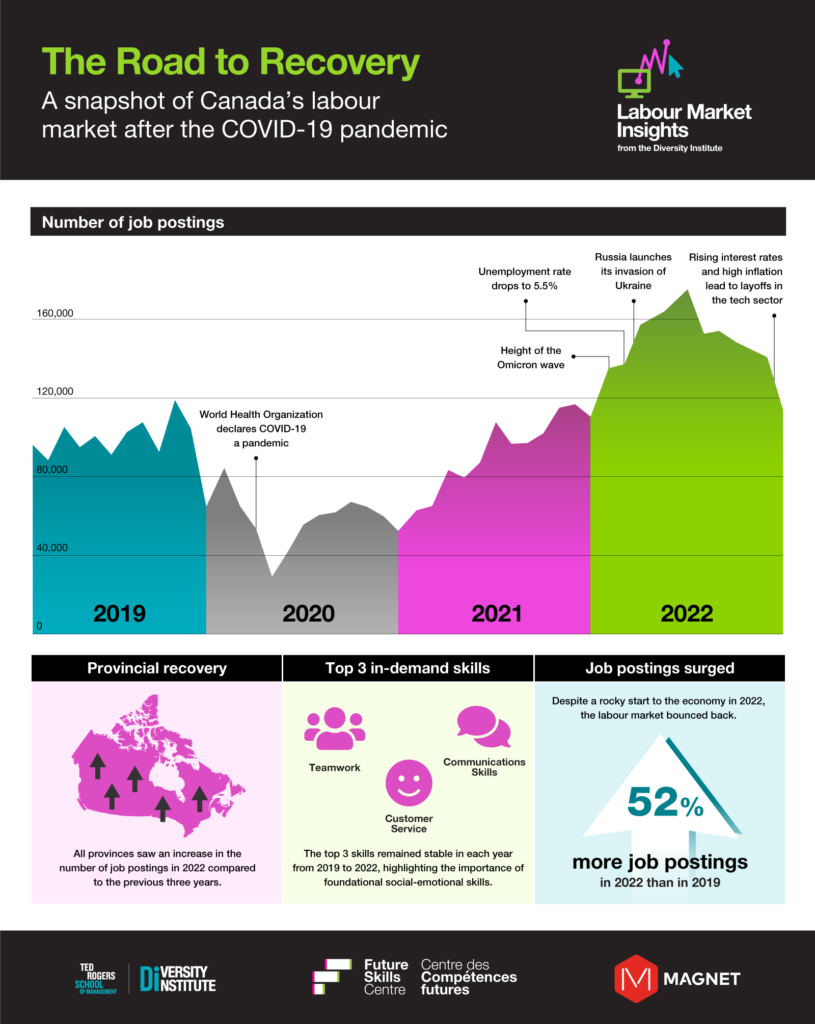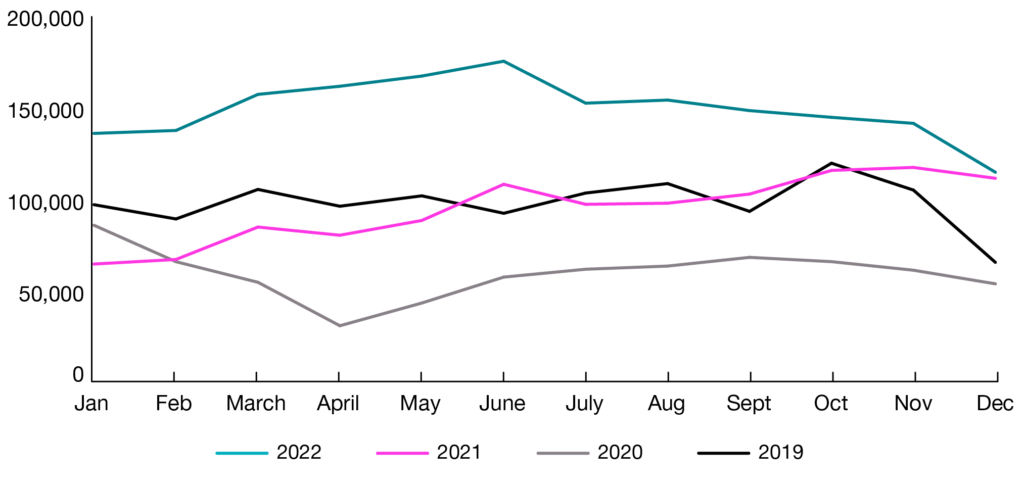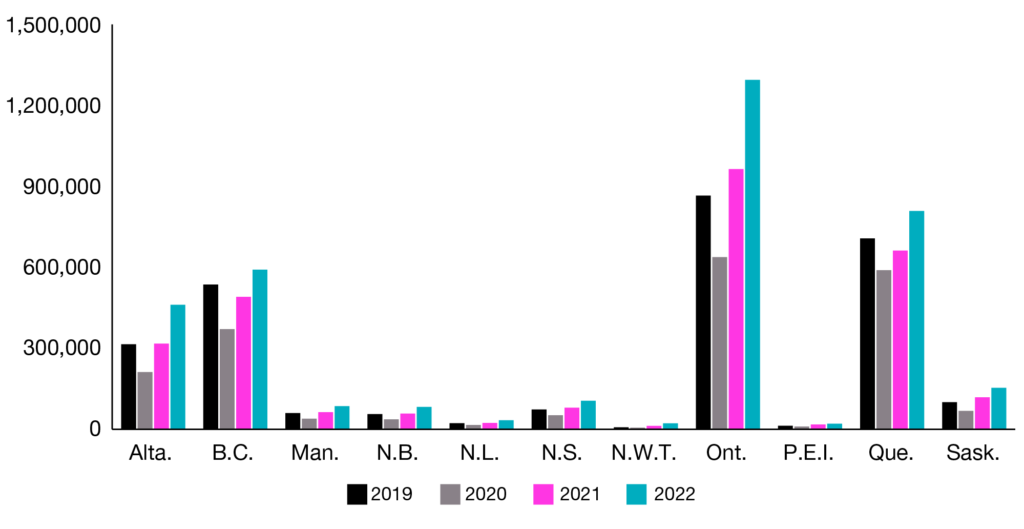Recovery of Canada’s Labour Market After the COVID-19 Pandemic

By the end of 2022 job postings were up across the country, exceeding pre-pandemic levels.

The Canadian labour market in 2022 carried over (PDF file) similar themes from 2021 as the unemployment rate continued to decline and the number of job postings began to soar. Roles across sectors emphasized the need for social-emotional skills, highlighting the value of such skills in a time of economic uncertainty and volatility. The year began at the height of the COVID-19 wave fueled by the Omicron variant, which led to another round of lockdowns and closures (external link) across the country. On February 24, Russia launched a major invasion of Ukraine, causing a surge in oil prices and contributing to the rise in commodity prices (external link) , which already had been affected by supply chain disruptions linked to pandemic restrictions. Rising interest rates, high inflation and a return to “normal” also led to layoffs in the tech sector (external link) , a field often considered immune to slowdowns (external link) .
Despite these hurdles, the unemployment rate dropped to 5.5% in February 2022 (external link) , its lowest since February 2020, before the COVID-19 pandemic. Throughout the year, Canada began to lift restrictions, easing travel regulations, social distancing and mask mandates. Women in Canada’s labour market experienced a rapid recovery (external link) in employment, surpassing that of men’s. The employment rate for women increased by 2%, or 178,000 jobs, compared to February 2020, while men’s employment increased by 1.9%, or 192,000 jobs, over the same period. In February 2022, the percentage of employed women within the core-age group of 25 to 54 years reached an all-time high of 81%, primarily due to a rise in full-time employment. Given that women occupy many of the industries that were hardest hit by the pandemic, like retail and hospitality, as these sectors continue to bounce back, the employment of women should similarly improve.
Researchers at the Diversity Institute examined labour market demand in 2022 using online job postings as an indicator by accessing data from the Vicinity Jobs Hiring Demand Analytic Suite, a platform that collects information on online job postings in Canada.
| 2019 | 2020 | 2021 | 2022 | % Change 2021 to 2022 | |
|---|---|---|---|---|---|
| Number of job postings | 1,168,787 | 704,996 | 1,127,257 | 1,780,807 | +60 |
While the onset of the pandemic was followed by a drastic decline in the number of job postings in 2020, the number has been on an upward trend since 2021. This rise continued into 2022, where job postings were up 60% from the previous year (Table 1). The number of job postings in 2022 was 52% higher than in 2019.
The increase in job postings in 2022 may reflect the challenges that businesses faced in filling the worker shortage caused in part by the pandemic. As employee absenteeism increased in 2022 due to the surge of the Omicron variant of COVID-19, along with influenza and other respiratory viruses, businesses may also have been looking to hire more staff to cover for absences. According to Statistics Canada’s December 2022 Labour Force Survey report (external link) , 8.1% of employees were absent due to sickness or disability during the week analyzed (December 4 to 10). This is up from 6.8% in November, and it surpasses the December monthly average of 6.9% from 2017 to 2019. Nevertheless, it is still lower than the highest record of 10% in January 2022, when the Omicron variant was spreading rapidly.

| Jan | Feb | March | April | May | June | July | Aug | Sept | Oct | Nov | Dec | |
|---|---|---|---|---|---|---|---|---|---|---|---|---|
| ’22 | 135,137 | 136,727 | 156,385 | 160,813 | 166,368 | 174,452 | 151,603 | 153,285 | 147,557 | 143,891 | 140,603 | 113,986 |
| ’21 | 63,974 | 66,460 | 84,116 | 79,666 | 87,703 | 107,415 | 96,504 | 97,106 | 102,072 | 114,968 | 116,591 | 110,682 |
| ’20 | 85,078 | 65,250 | 54,033 | 30,354 | 42,733 | 56,854 | 61,140 | 62,868 | 67,604 | 65,278 | 60,610 | 53,194 |
| ’19 | 96,284 | 88,534 | 104,616 | 95,457 | 101,118 | 91,617 | 102,646 | 107,791 | 92,662 | 118,900 | 104,263 | 64,899 |
Looking at the month-to-month comparisons (Figure 1), the number of job postings for every month in 2022 was higher than in 2021, but this difference became smaller as the year ended. This may reflect a reduced demand for workers as businesses looked to tighten their spending as interest rates rose, inflation increased and a possible recession loomed (external link) .
Examining job postings by region, all provinces saw an increase in postings in 2022 compared to the previous three years (i.e., 2019, 2020 and 2021). The number of job postings not only recovered from the pandemic, but it also exceeded pre-pandemic levels. The surge was particularly large for the northern territories, where the number of job postings in 2022 was 77% higher than in 2021. Alberta saw the second-largest increase at 45%, followed closely by New Brunswick at 43% and Newfoundland and Labrador at 42% (Figure 2).

| 2019 | 2020 | 2021 | 2022 | |
|---|---|---|---|---|
| Alta. | 315,000 | 211,976 | 317,507 | 461,245 |
| B.C. | 536,550 | 370,967 | 490,504 | 591,267 |
| Man. | 60,156 | 39,380 | 63,439 | 85,770 |
| N.B. | 56,224 | 36,653 | 58,167 | 83,086 |
| N.L. | 22,714 | 15,987 | 23,617 | 33,644 |
| N.S. | 73,307 | 51,840 | 80,260 | 105,826 |
| N.W.T. | 7,461 | 5,888 | 12,526 | 22,213 |
| Ont. | 865,777 | 638,035 | 963,842 | 1294,368 |
| P.E.I. | 12,996 | 10,080 | 17,842 | 20,873 |
| Que. | 707,225 | 589,424 | 662,146 | 808,891 |
| Sask. | 100,420 | 68,384 | 118,549 | 153,707 |
Looking at the top 10 skills sought in job postings, similar trends were observed from 2019 to 2021. Skills with the highest demand in 2022 were social-emotional, sometimes called “soft” skills. The top three skills remained stable across the years, with teamwork, communication and customer service being the most sought. Proficiency in English, which was a top-10 requirement in previous years, dropped to 14th place in 2022. For the first time in the four-year period, planning entered the top 10 list of skills in demand for 2022.
In summary, it is important to acknowledge that the number of job postings alone cannot provide a complete picture of the state of the economy. Employment levels, labour supply indicators like the unemployment rate, and the constraints and preferences of job seekers also provide context. Nonetheless, labour demand as represented by job postings can offer valuable insights into the locations and sectors where employment opportunities are available, and the skills that employers are prioritizing when seeking new employees.
The views, thoughts and opinions expressed here are the author’s own and do not necessarily reflect the viewpoint, official policy or position of the Future Skills Centre or any of its staff members or consortium partners.




